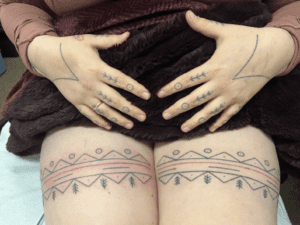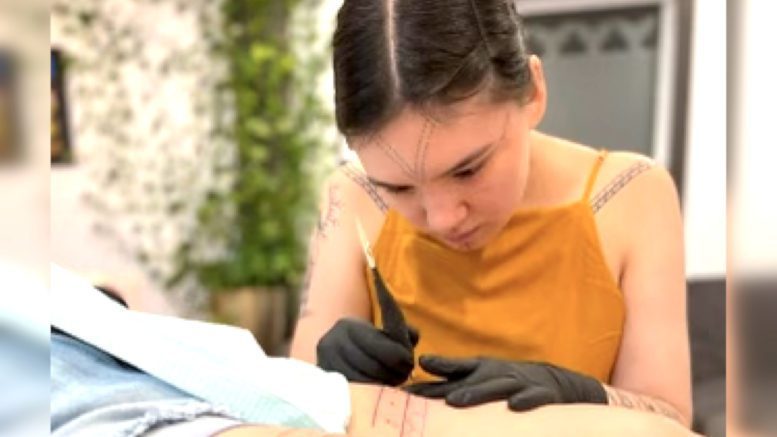Arsaniq Deer’s life changed the day she witnessed her mother receive traditional Inuit tattoos and at that moment, she says, was filled with a new sense of purpose.
“I would never forget those days, it was so special and so meaningful for me,” she says.
Deer is a 23-year-old artist from Nunavik, Quebec, travelling across the circumpolar north teaching the importance of preservation and culture through Inuit tattoos.
Over the course of a year, Deer has travelled the Northwest Territories as part of the Western Arctic Youth Collective (WAYC), to communities in the Inuvialiuit Settlement Region (ISR), their most recent being Paulatuk and Sachs Harbour.
She started tattooing in 2019 after the artist, Hovak Johnston, requested she draws a line on her mother’s thigh. Johnston, even gave her some left-over supplies to get her started.
“I’ve grown so much over the years and I feel like I found my purpose in my life,” Deer said. “It’s so amazing to witness this revitalization.”
Outside of her research and community influences, Deer says, she learned about traditional markings at Nunavik Sivunitsavut, a school focused on Inuit education.
Many of these markings symbolize rites of passage and significant milestones and events in a person’s life.
Her biggest challenge is in bridging the gaps and in sharing traditional beliefs and knowledge that have been lost over time, she says.
“Once in a while, I still get a negative reaction, but I try not to take it personally,” she explains.

Each marking tells a unique part of an individuals story, says Deer (Photo courtesy of Alyssa Carpenter)
“It’s healing generational trauma,” she says. “And bringing back this culture that was stolen from us.”
Deer says many appointments turn into therapy sessions and that often she and her clients build a special bond through this practice.
“We form connection a lot through these tattoos because it’s not just tattoos,” she says. “It’s our sacred markings that have been a part of us forever and it’s just now coming back.”
Tradition redefined
Alyssa Carpenter is the project director for WAYC and since the emergence of the workshop, she says, other communities have expressed great interest.
“We just really want to give the chance to folks who are curious and want to explore it a little bit.”
Carpenter uses her tattoos as a symbol of protection from past traumas and even had special markings done by Deer.
“Now I’m getting ready to do further markings, but I’m learning the meaning behind it. And I’m making it unique to myself and what I’m going through because I went through a lot of grief and I’m going through a lot of reconnection to my home community that I tried to leave behind,” she says.

“When I look down at my hands, I feel really powerful, and I feel really connected,” says Carpenter. (Photo courtesy of Alyssa Carpenter)
Carpenter notes that this is just the beginning. Understanding the importance of these markings and their effect on community starts with being open, re-introducing this practice, and sharing stories and knowledge.
“It’s not as known in this region (ISR) and our language is really impacted,” she says, “so to have something like this, I think is really special. And again, whether you support it or not, it’s totally fine.”
Carpenter is hopeful that WAYC can secure long-term funding to host more tattooing, language, sewing and other culture-based programs in the future.
“We just want to help people. And this might be one way to help people.”
The workshop is expected next in Ulukhaktok.
In the meantime, Deer says she’s working on her skin stitch, a similar technique used in sowing and embroidery.





